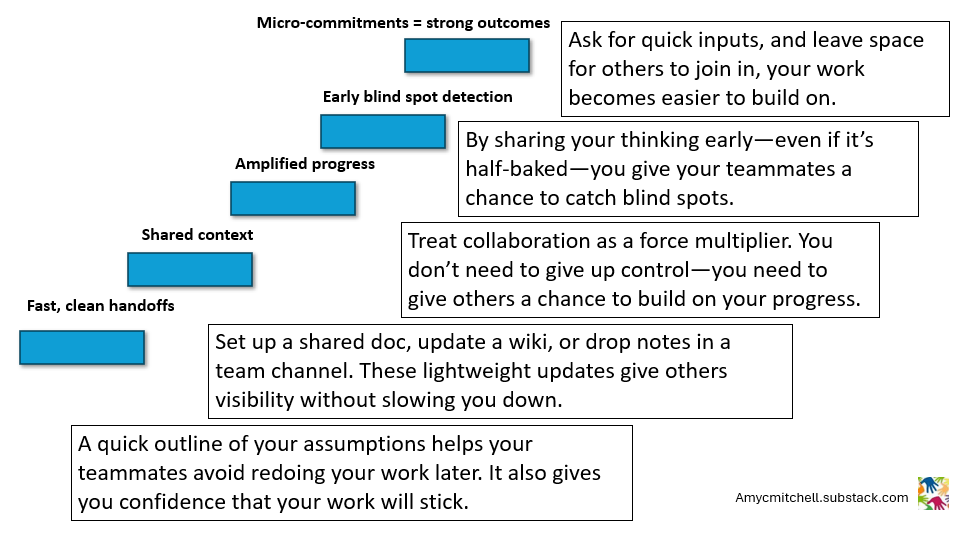Vivek had the perfect mix of technical depth and business intuition to take on almost any product challenge. He thrived in ambiguity and often volunteered for the messiest, most undefined projects. But instead of rallying a team, Vivek preferred to tackle challenges alone.
If a potential customer asked about a future capability, Vivek would research it and add it to the roadmap.
If a stakeholder requested a new partner integration, Vivek would bypass discovery and go straight to engineering with the ask.
If a customer wanted a discount, Vivek would approve it himself—margin was fine, so why not?
At first glance, Vivek looked like a dream product manager: fast, decisive, self-starting. In many organizations, that kind of independence would be celebrated.
But beneath the surface, trouble was brewing.
He made pricing and architectural changes without review. He committed to stakeholders before checking for blind spots. When the rest of the product team got looped in—usually late—they were left scrambling to clean up the mess.
What looked like bold ownership from the outside felt, inside the team, like isolation and risk. Meetings stalled while people waited for Vivek to clarify assumptions. Trust had to be rebuilt. And peer product managers were left to chase alignment and recovery work they didn’t sign up for.
Vivek wasn’t failing. But his solo style was causing stress—for him, and for everyone around him.
If you've worked in product long enough, you've probably met a Vivek - or been one. The patterns happen. Let's explore why solo product manager work persists, and what it costs teams in the long run.
Why This Situation Happens So Often
There are dozens of frameworks to guide product managers through customer discovery, roadmapping, and launch planning. But when it comes to collaborating with other product managers? There’s no playbook.
Product initiative ownership is vague. Goals are shared in theory but fuzzy in practice. And responsibilities shift as projects evolve, making it hard to know when to pull others in—or even who to pull in.
Now layer in high-growth expectations and mounting productivity pressure. Product managers are juggling more than ever. In that kind of environment, skipping collaboration can feel like the fastest way to keep things moving.
And then there’s the structure. In many flattened organizations, managers are stretched thin, managing too many reports to spot when collaboration is breaking down—or when solo wins are masking team strain.
Most product managers don’t want to work alone. But over time, exhaustion, habits, and a desire to stay in control can push them into solo mode.
The cost shows up across the team: confusion, duplicate work, missed handoffs, and misaligned stakeholder commitments. And the toll on the solo product manager—like Vivek—is often just as visible.
So what could Vivek—and the team around him—do differently to change the pattern and reduce the stress?
5 Strategies to Work Alone - Without Leaving the Team Behind
If you're a busy product manager like Vivek—or working with one—it’s easy to fall into a cycle of solo effort followed by team cleanup. But collaboration doesn’t mean micromanaging independent-minded peers. Small shifts in how you work can reduce friction, prevent rework, and actually support productive solo effort.
Working alone isn’t the problem. It’s forgetting to bring the team along that causes trouble.
Strategy 1: Plan for handoffs early
When you take initiative on an ambiguous effort, think ahead to the point where others will need to pick it up or build on it. A quick outline of your assumptions helps your teammates avoid redoing your work later. It also gives you confidence that your work will stick.
Strategy 2: Keep others in the loop asynchronously
Set up a shared doc, update a wiki, or drop notes in a team channel. These lightweight updates give others visibility without slowing you down. They also reduce the need for time-consuming “explain yourself” calls. You stay in the driver’s seat while your team stays informed.
Strategy 3: Let the team amplify your work
Treat collaboration as a force multiplier. You don’t need to give up control—you need to give others a chance to build on your progress. When you set the pace, others can follow and extend it. Over time, you'll benefit from the amplification when they do the same for you.
Strategy 4: Share early to avoid rework
In complex environments, small changes can ripple across systems. By sharing your thinking early—even if it’s half-baked—you give your teammates a chance to catch blind spots before they become blockers. This keeps your fast-moving work efficient, not error-prone.
Strategy 5: Ask for micro-commitments, not full-time partners
Product managers may not have capacity for a major collaboration, but they’ll often contribute a quick review or gut check. Asking for small inputs creates connection without creating drag.
You don’t have to stop working independently. But when you share context, ask for quick inputs, and leave space for others to join in, your work becomes easier to build on—and harder to undo.
The Unexpected Payoff of Teamwork
What should you take from Vivek’s experience? That working alone can be productive—until it isolates you from the people who can make your work stronger.
Solo progress is valuable. But blind spots, misalignment, and rework creep in when you forget to bring the team along. That’s what made Vivek’s work harder to support, even when it started strong.
When you balance independent effort with team connection, you get the best of both: fast progress and durable outcomes.
Here’s what that balance looks like:
Customer requests
Draft the approach on your own
Check with peers for similar requests
Update the roadmap together if there's broader demand
Stakeholder requests
Frame your initial idea individually
Get a quick team perspective
Share the recommendation and follow the standard development process
Discount discussions
Propose logic that considers more than margin
Loop in finance or other leads early
Align on the messaging before responding
In every case, you start with solo work—but you finish with the team. That’s how independent product managers create outcomes others can carry forward.
Summary - Work Solo And Bring Your Team Along
Great product managers often thrive in ambiguity and drive progress alone—but independence without connection can leave a trail of confusion and cleanup. This article explores why product manager collaboration can break down, what it costs, and five practical strategies to support solo work without isolating your team.
Work alone if you want to move fast—just don’t forget to leave a trail your team can follow.
Last week’s backstory for paid subscribers was about coordinating with other product managers. Does Self-Serve Product Management Coordination Work?
Paid subscribers get access to 13+ templates and quick start guides.🎁
TLDR Product listed Product Management IRL articles recently! This biweekly email provides a consolidated list of recent product management articles.
Check out Product Management Resources for free product management templates and guides.
Connect with Amy on LinkedIn, Threads, Instagram, and Bluesky for product management insights daily.







